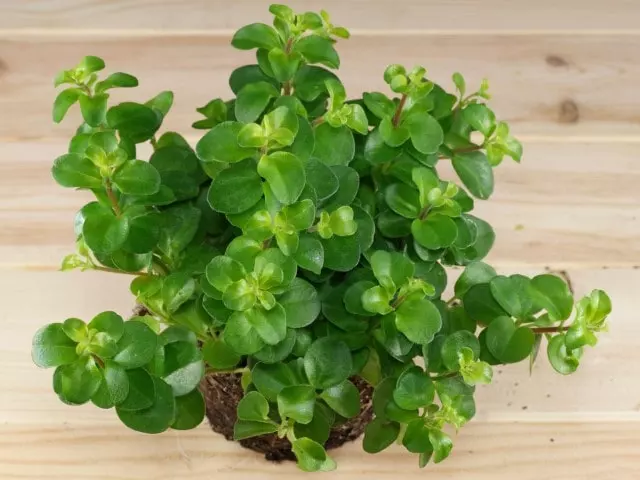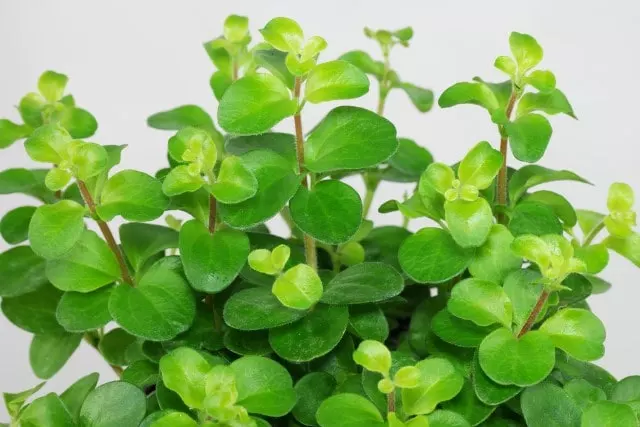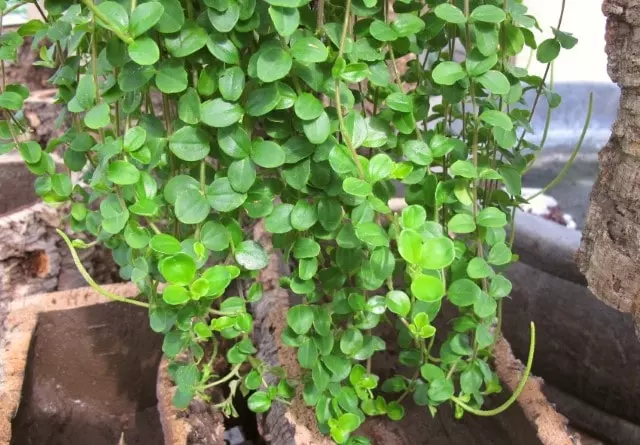Peperomia rotundifolia is a hanging plant that grows wild in the tropical forests of South America. In some of these regions, Peperomia rotundifolia is seen as a symbol of luck. When offered as a gift, it carries the message “everything will be fine”. A special plant for someone special! Learn all about Peperomia rotundifolia care in this article.
Table of Contents
Peperomia rotundifolia Care
It is not so easy to achieve the ideal conditions for the development of Peperomia rotundifolia, especially because of the environmental humidity requirements that it demands, and that is not easy to achieve in any home. However, little by little we can get the plant used to its new home, obtaining a fantastic tropical plant whose stems will fall down the pot and will simulate a very attractive vegetable cascade.
Temperature
We will locate our Peperomia rotundifolia indoors or outdoors in very warm areas, ensuring throughout the year stable temperatures of between 65 and 77 °F (18 and 25 º C). This range is habitual and easy to obtain in our home, reason why this part we have it quite obtained.
Lighting
Peperomia rotundifolia plants do best in bright, indirect sunlight. An east or west-facing windowsill is ideal for them at most times of the year. The only thing to keep in mind is that they don’t get too much direct sunlight during the summer months, as this can cause the leaves to burn.
If you place your Peperomia rotundifolia plant in a location where it does not receive enough light, it will tend to become brittle as it stretches out into the available light. If this happens, you can easily prune Peperomia back to maintain the compact appearance of the plant. To prevent this from happening, place the Peperomia plant in a suitable place as mentioned above.
Peperomia Humidity
Peperomia Humidity. This point is one of the main requirements of this plant to get well-hydrated leaves, green and without burnt edges or decayed appearance. Therefore, we need to locate our plant in the most humid area of the house. For example, a bathroom with access to natural light, or in the kitchen, which are usually the most humid areas of a house.
In addition, we will also apply every few days, in the driest and hottest season (late spring and summer), distilled water with a sprayer, spraying all the leaves and increasing the relative humidity of the environment. You can automate this operation by placing a humidifier near Peperomia rotundifolia.

Type Of Substrate and Pot for Peperomia rotundifolia
This species of Peperomia prefers humid conditions with plenty of organic materials, detritus, and decomposing organic matter. Therefore, it is somewhat demanding to fertile soils, so we will look for a mixture of peat and coconut fiber.
Peat provides a texture similar to organic matter, as well as essential nutrients for plant development. On the other hand, coconut fiber is a natural substrate that improves oxygenation and drainage when watering, also important to avoid any kind of rotting in our plant.
In summary, 70-80% peat or humus substrate, is added to 20-30% coconut fiber to improve drainage. Peat is recommended to be slightly acidic, as it is the point where more nutrients can be absorbed by the roots of Peperomia rotundifolia.
Peperomia rotundifolia Watering
You should water a Peperomia rotundifolia plant once the top of the soil has dried out completely, and then water the plant thoroughly.
Watering Peperomia rotundifolia plants is where things usually go wrong. Overwatering is the main problem people have when keeping Peperomia plants indoors. Many of us overwater indoor plants, and this is not a good thing.
Signs of overwatering Peperomia rotundifolia plants can be rotting stems, wilted or yellowing leaves, heavy potting, and waterlogged soil.
I usually only water my Peperomia rotundifolia plants every 7-10 days, but I always go by the dryness of the soil, rather than the length of time since they were last watered.
Application Of Fertilizers
Peperomia species have very light fertilizer needs, and you are more likely to have problems if you fertilize too often than if you fertilize infrequently. I usually use a balanced 10-10-10 water-soluble fertilizer once a month during the growing season for my Peperomia plants.
You have to be quite careful not to over-fertilize your Peperomia plants, as this can cause a combination of problems resulting in toxicity of some nutrients and deficiency of others, which will lead to your plant being very unhappy.
- ALL PURPOSE: 10-10-10 with Aminos (5.5%) & Seaweed Extract is a generic liquid fertilizer designed for all stages of plant growth.
- USE SITES: Great for gardens, flowers, fruits, vegetables, turf grasses etc. Is suitable for indoor & outdoor use
- USAGE RATES: 1-2 oz per gallon of water (it's better to start at a lower rate and work your way up) | Water generously & continue use every 1-2 weeks
Peperomia rotundifolia Propagation
Propagating Peperomia rotundifolia plants is easy, and it’s a great way to expand your plant collection or share your beautiful plants with friends and family.
Peperomia rotundifolia is propagated from leaf cuttings, like African violets. The best time for propagating Peperomia is spring, but rooting can also be done in the fall.
Follow these steps to learn how to propagate Peperomia rotundifolia.
- Cut off the Peperomia leaf along with some stem.
- Put several of the cuttings in a pot and just bury them a little, 0.4″ (1 cm) or so.
- Press the soil around the cuttings after watering.
- Cover the pot with a plastic bag or a “soda bottle”; make several holes in the bag or soda bottle for air circulation.
- Leave the pot at room temperature and in a shady place.
- Remove the plastic bag or soda bottle regularly to let fresh air in and prevent rotting.
- New plants will start growing from the base of the leaves. When the Peperomia plant is well rooted and large enough, it can be transplanted into individual pots.
You can make homemade rooting hormone to make it easier for your Peperomia to root.

Are Peperomia Plants Toxic to Cats?
Fortunately, Peperomia rotundifolia plants are completely safe for humans and pets. There is no danger to your pets from contact or ingestion. Although I’m sure its taste is not very pleasant, you need not worry if your pet likes to nibble on a leaf here or there.
Likewise, it is reassuring for people with young children, who can safely place Peperomia plants anywhere in their home without wondering if there is any risk to their children’s health.
If you like Peperomias we recommend our article about Peperomia nivalis and Peperomia obtusifolia variegata.


